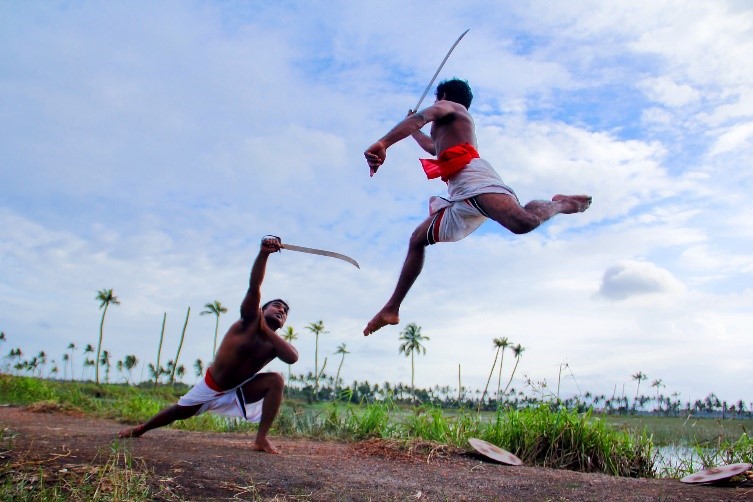 |
|
|
|
|
| General Information |
Kalaripayattu is a traditional Indian martial art with strong links to yoga and ayurveda. ‘Kalari’ refers to the traditional military training arena in which the art is practiced. Usually they are located partially under ground level and in east-west direction. Inside the atmosphere is stable and suitable for physical training. The daily religious life with its rituals also takes plays in the arena. The relation between the spiritual life and the daily training is embodied in the physical exercises (Denaud 2009: 24-5). ‘Payattu’ refers to exercise.Kalaripayattu strongly focuses on health as well. Knowledge about medicine is traditionally incorporated in the curriculum.Kalaripayattu is very elegant and acrobatic, often traditional dance is reflected in the art as well (Kalarippayat Academy, n.d.). The other way around, techniques and movements of kalaripayattu can also be seen in velakali, a martial folk dance (Zarilli 1986: 2. 26).There are three stages in the training of kalaripayattu called meithari, kolthari and ankathari. First students learn stretching and flexibility exercises, jumps and exercises to control the body. The use of weapons like swords, daggers, spears, maces, and bows and arrows is introduced the last two stages. Only when a student is physically, spiritually, and ethically ready he can start weapon training. If the body and mind are fully prepared, the weapon becomes a natural extension of body and mind (Kalarippayat Academy, n.d.; Denaud 2009: 29).The instruction of student starts at the age of eight. Students are not assigned a grade or belt. There are no competitions, only demonstrations (Denaud 2009: 24, 28). The relation between spiritual life and the daily training is embodied in the physical exercises (Denaud 2009: 27). |
| History/Development |
Kalaripayattu is believed to be one of the world’s oldest known martial arts systems. It originated in Kerala, India. The compound term was first used in the twentieth century to identify the traditional martial art dating from at least the 12th century in the forms still practiced today, but with roots in both the Tamil and Dhanur Vedic martial traditions (Zarrilli 2001: 225). |
Transmission
(Policies/institutions) |
|
| Relevant Organisations |
- Kerala Kalarippayat Academy
www.kalarippayat.co.uk
- Indian Kalaripayattu federation (IKF)
https://www.indiankalaripayattufederation.com/about-us.php
- Kalaripayattu Federation of India (KFI)
http://kalaripayattufedindia.org/index.php |
| Additional Materials |
|
| References |
- Kerala Kalarippayat Academy
www.kalarippayat.co.uk
- Denaud, P. (2009). Kalaripayat. The Martial Arts of Tradition of India. Toronto, Canada: Destiny Books.
- Zarrilli, P. B. (1986). “From Martial Art to Performance: Kalarippayattu and Performance in Kerala. Part 1 and 2.” Sangeet Natak 81–82: 5–41; 83: 14–45.
- Zarrilli, P.B. (2001). “Kalaripayattu”. In Green, T. and Svinth, J. (eds.) Martial Arts of the World: An Encyclopedia of History and Innovation. Santa Barbara, CA: ABC-CLIO. | | |